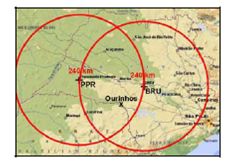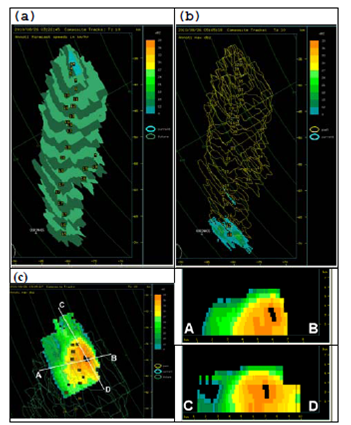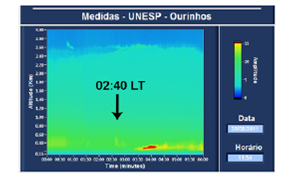Servicios Personalizados
Revista
Articulo
Indicadores
-
 Citado por SciELO
Citado por SciELO -
 Accesos
Accesos
Links relacionados
-
 Similares en
SciELO
Similares en
SciELO
Compartir
Revista Boliviana de Física
versión On-line ISSN 1562-3823
Revista Boliviana de Física v.20 n.20 La Paz 2012
Raman Lidar monitors emissions from sugar cane fires in the State of São Paulo: A Pilot-Project integrating Radar, Sodar, Aerosol and Gas observations
G. Held1, F.J.S. Lopes2, J.M. Bassan1, J.T. Nery3, A.A. Cardoso4, A.M. Gomes1, T. Ramires3, B.R.O. Lima5, A.G. Allen4, L.C. da Silva4, M.L. Souza4, K.F. de Souza6, L.R.F. Carvalho6, R.C. Urban7, E. Landulfo2, A.M. de Decco1, M.L.A.A. Campos7, M.E.Q. Nassur7, R.F.P. Nogueira4
1 Instituto de Pesquisas Meteorológicos, UNESP, Bauru, S.P., Brazil
Tel: +55 14 3103-6030, Fax: +55 14 3203-3649, E-nail: gerhard@ipmet.unesp.br
2 Centro de Lasers e Aplicações, IPEN/CNEN, São Paulo, S.P., Brazil
3 Campus Experimental de Ourinhos, UNESP, Ourinhos, S.P., Btazil
4 Instituto de Química, UNESP, Araraquara, S.P., Brazil
5 Instituto de Geociências, Unicamp, Campinas, S.P., Brazil
6 Instituto de Química, USP, São Paulo, S.P., Brazil
7 Departemento de Química, USP, Riberão Preto, S.P., Brazil
SUMMARY
Ourinhos is situated in one of the major sugar cane producing regions in the State of São Paulo, where the manual harvesting is generally preceded by burning the foliage, resulting in large quantities of aerosols being emitted into the atmosphere. A one- month pilot study was executed during August 2010, to characterize the effects of those emissions on the atmosphere, considering the local circulation and the consequences for the region. The plumes were tracked by IPMet´s two S-band Doppler radars, also deploying a large range of meteorological, physical and chemistry instrumentation: a mobile Lidar with Raman channel to observe elevated layers and the type of aerosols, a medium-sized Sodar, as well as 6 Automatic Weather Stations spread through town. Various gases and particulates were also sampled, providing the atmospheric chemistry data base and thus documenting the impact on the region.
This paper highlights a case study on 26 August, when a plume was tracked by TITAN Radar Software from the start of the fire, moving southwards at 14-17 km.h-1 with the winds at about 3,5 km above ground level, until it reached Ourinhos 2h15min later, where it was observed by the Raman Lidar and also detected by the aerosol and gas samplers. The high aerosol load of the atmosphere was confirmed by hourly mean values of AOD varying between 0,265 and 0,288 until 07:00 LT, after which they increased to 0,433 by 09:00 LT, as well as hourly mean backscatter profiles. Hourly values of the Lidar Ratio identified the aerosols as biomass burning products, also confirmed through the analysis of gas and aerosol samples simultaneously collected at the Lidar site.
Key words: Raman Lidar, biomass fire plumes, Doppler Radars, Sodar, Aerosol & Gas Sampling
INTRODUCTION
Ourinhos is situated in one of the major sugar cane producing regions in the State of São Paulo, where the sugar cane is harvested from April until November. Sectors of the plantations are generally burnt prior to manual harvesting. This practice results in large quantities of aerosols being emitted into the atmosphere, not only negatively affecting local towns, but also regions much further away (Held et al., 2011). A one-month pilot study was executed during August 2010, to characterize the effects of those emissions on the atmosphere, considering the local circulation and the consequences for the region. In the absence of rain during the dry winter season, the plumes were tracked by IPMet´s two S- band Doppler radars, also deploying meteorological, physical and chemistry instrumentation: a mobile Lidar with Raman channel to observe elevated layers and the type of aerosols, a medium-sized Sodar, as well as 6 Automatic Weather Stations spread through town. Gases and particulates were also sampled, providing the atmospheric chemistry data base and thus documenting the impact on the region.
METHOD AND RESULTS
The region of Ourinhos was chosen, because the local Campus of UNESP (Universidade Estadual Paulista) maintains a network of 6 Automatic Weather Stations (plus one from INMET, the National Meteorological Institute), and it falls within the 100-120 km range of IPMet´s radar in Bauru (Figure 1), facilitating the tracking and quantitative analysis of such plumes in real time.

Figure 1. IPMets radars with their quantitative range.
Instrumentation
The Lidar, Sodar, radiosonde and air quality monitoring equipment (particulate samplers and active gas monitors) were all installed at the UNESP Campus in Ourinhos on the north- western outskirts of town (448 m above mean sea level - amsl), as well as the Automatic Weather Station (AWS) of INMET.
The mobile bi-axial Raman Lidar system uses a commercial pulsed Nd:YAG laser, operating at a wavelength of 532 nm, with a pulse energy of 130 mJ at 20 Hz PRF. The pulse width is 25 ns, yielding a spatial resolution of 7,5 m. A detailed description of the system is found in Landulfo et al. (2010). The system allows the determination of the optical properties of the atmosphere, like Backscatter Coefficient, Coefficient of Extinction (quantification of aerosol loading of the atmo- sphere) and the Lidar Ratio (indication of types of aerosols).
The vertical range of the Sodar was set at 800 m above ground level (AGL), with a vertical resolution of 10 m and sampling intervals of 60 min averaged every 30 min on a sliding scale. The products generated are horizontal wind speed & direction, vertical wind velocity, as well as by inference the estimated height of the thermal inversion.
IPMets radars cover the central and western State of São Paulo (Figure 1). Both have a 2° beam width and a quantitative range of 240 km, generating a volume-scan every 7,5 minutes, with a resolution of 250 m radially and 1° in azimuth, recording reflectivities and radial velocities at 16 elevations. However, in order to register and track the queimadas, a special scanning cycle was introduced to provide a better vertical resolution up to the anticipated detectable top of the plumes: 10,0º; 8,0º; 6,5º; 5,0º; 4,0º; 3,2º; 2,4º; 1,6º; 0,8º; 0,3º, with each sweep (PPI) having 360 rays with 957 range bins each. Two different systems of Software were deployed, viz. IRIS (Interactive Radar Information System) Analysis, to first generate CAPPIs (Constant Alitude PPIs) at 1,5 and 2,0 km amsl in order to identify all queimadas within the 240 km range of the radars. Once a queimada was identified to pass over the monitoring site, it was tracked by the TITAN (Thunderstorm Identification, Tracking, Analysis and Nowcasting; Dixon and Wiener, 1993) Software to determine its intensity (based on radar reflectivity in dBZ), horizontal and vertical dimensions, and the velocity of approach. The thresholds used for tracking were 10 dBZ with a minimum volume of 2 km3. It should be noted, that TITAN uses Universal Time (Local Time LT = UT-3h).
Since it is extremely important for the population in the Region to characterize the air quality, some gases (NO2, SO2, O3, Aldehydes) monitored and soluble aerosols sampled in different size fractions, including elementary carbon, during different periods of the day (10:00-16:00 and 20:00-06:00 LT), and also Polycyclic Aromatic Hydrocarbons (HPA). Ion chromatographic analysis would allow the identification of possible sources, especially biomass burning products, like Potassium (K+) and water-soluble organic carbon (WSOC).
Case Study of 25-26 August 2010
Based on a synoptic analysis for the Ourinhos Region, the month of August can be divided into two distinct periods, viz., 01-15 August, when 3 cold fronts crossed the State, causing light rain and very low temperatures especially at the beginning of the month, while during the second half the weather was dominated by a high pressure system, resulting in the temperatures to rise, but with low humidity, favoring the accumulation of pollutants in the regional air. The case study from 25 to 26 August 2010 was characterized by exactly such conditions.
The first echo of a smoke plume was detected by the Bauru radar on 26 August 2010 at 00:08 LT, about 35 km north- north-east of Ourinhos and ca 85 km south-west of the radar, rapidly gaining in area and intensity (=40 dBZ near its origin). By 00:22 LT, TITAN could already identify its centroid and tracked it until 02:45 LT, when the plume had already spread over Ourinhos. As the plume moved southwards with the northerly winds, the aerosols spread out (dispersed) and the reflectivity dropped gradually until 02:45 LT, but it could still be detected by the radar until 03:46 LT, >20 km south of Ourinhos, using a reflectivity threshold of -6 dBZ.

Figure 2: Tracks generated by TITAN on 26 August 2010. The envelopes (10 dBZ reflectivity) show the position of the queimada in intervals of 7,5 min (blue = actual time; green = future; yellow = past).
(a)First TITAN centroid of the queimada (fire) at 03:22UT (00:22LT; annotation: propagation velocity in km.h-1);
(b)The queimada reached the Ourinhos area at 05:45UT (02:45LT; annotation: max reflectivity in dBZ);
(c)Max-CAPPI and cross-sections, showing the horizontal and vertical extent along the base lines at 03:45UT.
Although during the night from 25 to 26 August, there were several other queimadas active and contributing to the overall aerosol load in the region, this study only concentrates on the history of the above plume, as illustrated by the TITAN- generated images in Figure 2.
Furthermore, it can be deduced from Figure 2a, that while the plume was at low heights at the beginning, it moved very slowly (3-4 km.h-1) since the wind speed in the first few hundred meters was very low (=5 m.s-1), as observed by the Sodar. It also showed a shift of the wind direction from easterly to northerly winds >300 m AGL. These northerly winds were above the nocturnal surface inversion and are confirmed by the Skew T x Log P profiles of the Meso-Eta Model in the layer 900-800 hPa (650–1650 m AGL). The vertical velocity w indicated that downward mixing of the pollutants (aerosols), trapped above the inversion, only commenced at around 09:00 - 09:30 LT, since from 00-06 LT and from 06-09:00 LT the atmosphere was extremely stable below 300 m AGL (w = ±0 m.s-1).
The Lidar was operating continuously from 25/08/2010 to 27/08/2010, also recording the Raman Channel during the night. Considering the radar images in Figure 2, the queimada arrived over the municipal area of Ourinhos between 02:30 and 02:45 LT. Figure 3 visualizes the Lidar observation between 00:00 and 06:00 LT up to a height of 3 km AGL. The arrival of the queimada aloft is marked with an arrow. Furthermore, a distinct cut-off at ca 2,6 km AGL is visible, which coincides with the top of the Planetary Boundary Layer, above which a very dry and relative warm and clean air was advected from the west above ca 730 hPa, creating an elevated inversion which blocked further upward mixing. The lowest layer =250 m AGL appears clean, being trapped within the surface inversion, which inhibits downward mixing, also confirmed by the Sodar measurements, indicating a very stable layer. Above it, during the first hours of the day, regional remnants of aerosols are observed, until the plume arrived at 02:40 LT between 350 and 600 m AGL, being transported by northerly winds.

Figure 3. LIDAR signal (arbitrary units) visualized from 00:00-06:00 LT up to 3 km AGL.
A quantitative analysis of the Lidar observations was performed by first integrating the data from the Raman Channel (non-elastic signal at 607 nm) into hourly means until 09:00LT to obtain the Aerosol Optical Depth (AOD). The results confirmed a high aerosol load of the atmosphere, with hourly mean values of AOD varying between 0,265 and 0,288 until 07:00LT, thereafter increasing to 0,433 by 09:00 LT.
Backscatter Profiles at 532 nm were generated for every hourly integrated period, showing an aerosol load up to about 2,6 km AGL. The first Backscatter profiles (00:00-02:59 LT) represent the regional pollution load, while from 03:00 LT onwards, a specific plume (as identified by TITAN, Figure 2) arrived at Ourinhos above the temperature inversion. Thereafter, the Backscatter Signal peak gradually increased from 0,003 to 0,004 km-1.sr-1 at 03:40-04:20 LT, with a further increase to 0,0056 km-1.sr-1 by 11:00 LT, after which the peak of the Backscatter Signal is decreasing due to turbulent mixing of the atmosphere.
Hourly means of the Lidar Ratio show an increase during the period 02:00-02:59 LT, confirming the arrival of the queimada from the north, while an almost 20% increase to 72 sr after 07:00 LT is probably due to downward mixing of the nocturnal queimadas, also confirmed by an increase of AOD values from the Raman signal. According to Catrall et al. (2005), aerosols originating from biomass burning have LR values between 59 and 70 sr. Omar et al. (2009) also suggest LR values of around 70 sr for biomass aerosols. Following these suggested values, the LR calculated for the observations on 26 August 2010 are most likely due to aerosols generated during biomass fires in the region.
CONCLUSIONS
In conclusion, it can be confirmed, that the smoke plume emitted by a sugar cane fire, observed by IPMet´s Bauru radar and tracked with the TITAN Software did reach the municipal area of Ourinhos during the early hours of the morning of 26 August 2010, and was also registered by the Lidar in a layer above 350 m AGL, but was initially prevented from mixing downwards by the very stable atmospheric conditions, as implied by low aerosol concentrations collected during the nocturnal period 22:00 – 06:00 LT. However, the chemical analyses (10:00 – 16:00 LT), as well as the Lidar parameters, pointed at daytime downward mixing of the suspended aerosols, as soon as the stable Boundary Layer conditions were eroded by increasing daytime temperatures. This, in turn, would directly result in a negative impact on the health and well-being of the population in that region. Relatively high background concentrations of aerosols observed at the monitoring site indicate an accumulation of pollutants during prolonged periods of stable atmospheric conditions, being responsible for respiratory problems of the population due to the very fine particulate matter in suspension.
ACKNOWLEDGMENTS
FUNDUNESP is thanked for support to conduct the collection of meteorological and Lidar data during this Pilot Campaign (Processo 00598/10-DFP) and to present the paper. The chemical sampling was done by participants of FAPESP Project Effects of emissions on current and future rainfall patterns in Southeast Brazil (Processo No. 2008/58073-5).
REFERENCES
1.- Cattrall C, Reagan J, Thome K and Dubovik O, 2005. Varia-bility of aerosol and spectral lidar and backscatter and extinction ratios of key aerosol types derived from selected Aerosol Robotic Network locations, Journal of Geophysical Research, 110, D10S11. [ Links ]
2.- Dixon M and Wiener G, 1993. TITAN: Thunderstorm Identi-fication, Tracking, Analysis & Nowcasting - A radar-based methodology, J. Atmos. Oceanic Technol., 10, 785-797. [ Links ]
3.- Held G, Landulfo E, Lopes FS, Arteta J, Marecal V and Bassan JM, 2011. Emissions from sugar cane fires in the central & western State of São Paulo and aerosol layers over Metropolitan São Paulo observed by IPEN´s lidar: Is there a connection? Opt.Pura. Apl., 44 (1), 83-91. [ Links ]
4.- Landulfo E, Jorge MP, Held G, Guardani R, Steffens J, Pinto SdAF, Andre IR, Garcia A G, Lopes FJS, Mariano GL, da Costa RF and Rodrigues PF, 2010. Lidar observation campaign of sugar cane fires and industrial emissions in the State of São Paulo, Brazil. SPIE Digital Library, Proc. SPIE, Vol. 7832, 783201 (2010), 8pp; doi: 10.1117/12.866078. [ Links ]
5.- Omar AH, Winker DM, Kittaka C, Vaughan MA, Liu Z, Hu Y, Trepte CR, Rogers RR, Ferrare RA, Lee KP, Kuehn RE and Hostetler CA, 2009. The CALIPSO Automated Aerosol Classification and Lidar Ratio Selection Algorithm, Journal of Atmospheric and Oceanic Technology, 26, 1994-2014. [ Links ]














